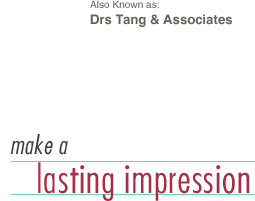
|
 |
 |
Dr
Tang Kok Weng
BDS
(S'pore) DGDP RCS (UK)
MSc (Implant Dentistry)
with Distinction (UK)
Dr Quek Li Wei
BDS
(S'pore)
Dr Leo Sze Yin
BDSc
(Australia, UQ)
|
|
 |
 |
Mon
- Fri
Sat
Sun & Public Holidays | :
8.30am - 5.30pm
: 8.30am - 1.00pm
: Closed |
|
|
|
Powered
by EMF EMF
|
 |

Laser Dentistry
What is Laser Dentistry?
LASER
means Light
Amplification
for Stimulated
Emission
of Radiation.
A
laser handpiece is an instrument that produces a very narrow, intense
beam of light energy. When laser light comes in contact with tissue,
the energy produced by the laser can remove or modify the shape and
volume of the tissue.
Lasers have been used in dentistry since
the early 1990s and can be used as a safe effective treatment
for a wide range of dental procedures and are often used in conjunction
with other dental instruments.
How are Lasers used in Dentistry?
Dental lasers can be used to:
* reduce the discomfort from ulcers and
cold sores
* expose partially erupted wisdom teeth
* perform excisional biopsy procedures
* help treat infections in root canals.
* manage gum tissues during impressions
for crowns, bridges or implant procedures
* remove excessive or overgrown tissues
which interfere with normal functions
* remove inflamed gum tissues and aid in
the treatment of gum disease
* remove or reshape gum and bone tissues
during crown lengthening

Why Laser Dentistry? What are the
benefits?
Dentists may not need to administer anesthesia or injections
in some
procedures, allowing the patient to enjoy a more relaxed
dental
experience.
Moreover, laser procedures allow more precision and can be controlled; can
reduce symptoms and healing times associated with traditional
therapies; reduce the amount of bacteria in both diseased gum tissue
and in tooth cavities and can even amazingly control bleeding during surgery.

|
|
 |
|




 EMF
EMF
 Tel: +65 6226 2296
SMS/Whatsapp: +65 9298 7982 Email:
service.adc@outlook.com
Tel: +65 6226 2296
SMS/Whatsapp: +65 9298 7982 Email:
service.adc@outlook.com